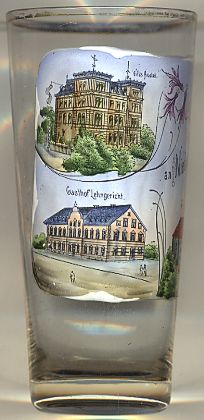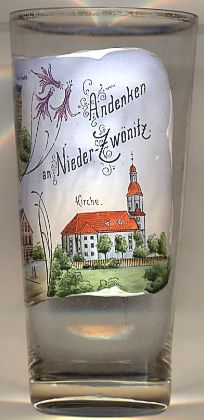

|
| DEUTSCHLAND | GERMANY |
| Bundesland: Freistaat Sachsen | Saxony |
| Landkreis: Erzgebirgskreis |

 Zwönitz is situated at an elevation of 550 m near the source of the Zwönitz stream, about 25 km southwest of Chemnitz.
The following villages were incorporated into the municpality of Zwönitz in the 20th century: Niederzwönitz (1934), Lenkersdorf (1952), Kühnhaide (1961),
Dorfchemnitz 1998, and Brünlos and Günsdorf (both 1999). Zwönitz has a population of about 11,300 (2008).
Zwönitz is situated at an elevation of 550 m near the source of the Zwönitz stream, about 25 km southwest of Chemnitz.
The following villages were incorporated into the municpality of Zwönitz in the 20th century: Niederzwönitz (1934), Lenkersdorf (1952), Kühnhaide (1961),
Dorfchemnitz 1998, and Brünlos and Günsdorf (both 1999). Zwönitz has a population of about 11,300 (2008).
The area had originally been settled by Slavic settlers, the Sorbes. German settlements existed since about the end of the 12th century. At least since 1286 Zwönitz was in possession of the monastery of Grünhain. Around 1300 the town was chartered, the privilege of holding markets was obtained in 1545. After the partition of Leipzig (1485) Niederzwönitz came in possession of the Albertine line of the Wettin dynasty while Zwönitz was obtained by the Ernestine line. After the War of Schmalkalden (1547) Elector Johann Friedrich I (Ernestine line) lost his electoral dignity which was transfered upon Duke Moritz of Saxony (Albertine line). The Treaty of Naumburg (1554) confirmed that large parts of the Ernestine possessions, including Zwönitz, were awarded to the Albertine line. Nevertheless, Zwönitz and Niederzwönitz remained separte communities. Niederzwönitz was incorporated into the municipality of Zwönitz only in 1934.
The  church of Sankt Trinitatis [bottom right picture]
was built between 1688 and 1692. The north tower with its square ground plan, a hexagonal upper storey and an octogonal belfry was added in 1724.
church of Sankt Trinitatis [bottom right picture]
was built between 1688 and 1692. The north tower with its square ground plan, a hexagonal upper storey and an octogonal belfry was added in 1724.
The  Villa Austel [top left picture]
was built in 1885/1886 by the local Austel family.
After World War II the building housed the Russian town's headquarters for a short period.
During the period of the German Democratic Republic the building at first served as an office building and then was used as a
accomodation for apprentices of the local Landwirtschaftliche Produktionsgenossenschaft LPG).
After the re-unification of Germany, the villa was returned into the hands of the municipality.
A restaurant operates on one floor of the building.
Villa Austel [top left picture]
was built in 1885/1886 by the local Austel family.
After World War II the building housed the Russian town's headquarters for a short period.
During the period of the German Democratic Republic the building at first served as an office building and then was used as a
accomodation for apprentices of the local Landwirtschaftliche Produktionsgenossenschaft LPG).
After the re-unification of Germany, the villa was returned into the hands of the municipality.
A restaurant operates on one floor of the building.
The bottom left picture shows the
 Gasthof
Gasthof
![[scale]](lineal.jpg)